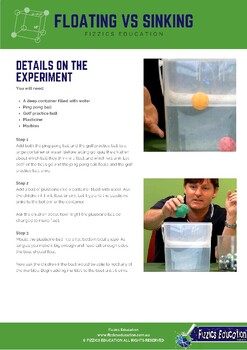Floating vs sinking - teacher demonstration
Fizzics Education
9 Followers
Grade Levels
PreK - 1st
Subjects
Resource Type
Standards
NGSS3-PS2-1
NGSSK-PS2-1
Formats Included
- PDF
- Easel Assessment
Pages
2 pages
Fizzics Education
9 Followers
Easel Assessment Included
This resource includes a self-grading quiz students can complete on any device. Easel by TPT is free to use! Learn more.
Description
- 2 sheets in total in A4 format
- Background information on the science experiment
- A list of the experiment materials needed (uses simple materials found in local shops, at home or in the classroom)
- The method on how to conduct the science experiment in your classroom
- Reflection sheet with questions that determine student understanding
Follow the Fizzics Education Teachers Pay Teachers Store :)
Going Further
Working with Water school incursion!
Have this award-winning school science incursion visit your school as either an on-site visit or interactive online program.
NB: The author is Australian and as such uses British English (BE) spelling
Total Pages
2 pages
Answer Key
N/A
Teaching Duration
30 minutes
Report this resource to TPT
Reported resources will be reviewed by our team. Report this resource to let us know if this resource violates TPT’s content guidelines.
Standards
to see state-specific standards (only available in the US).
NGSS3-PS2-1
Plan and conduct an investigation to provide evidence of the effects of balanced and unbalanced forces on the motion of an object. Examples could include an unbalanced force on one side of a ball can make it start moving; and, balanced forces pushing on a box from both sides will not produce any motion at all. Assessment is limited to one variable at a time: number, size, or direction of forces. Assessment does not include quantitative force size, only qualitative and relative. Assessment is limited to gravity being addressed as a force that pulls objects down.
NGSSK-PS2-1
Plan and conduct an investigation to compare the effects of different strengths or different directions of pushes and pulls on the motion of an object. Examples of pushes or pulls could include a string attached to an object being pulled, a person pushing an object, a person stopping a rolling ball, and two objects colliding and pushing on each other. Assessment is limited to different relative strengths or different directions, but not both at the same time. Assessment does not include non-contact pushes or pulls such as those produced by magnets.




